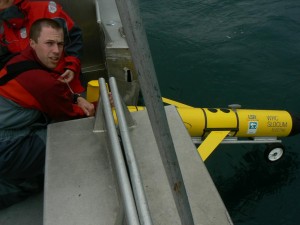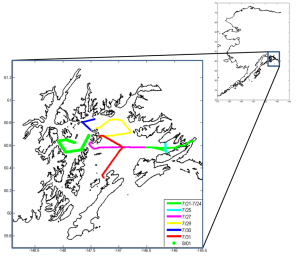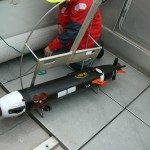During the experiment, scientists collected nearly continuous measurements of temperature and salinity using two autonomous underwater vehicles (AUVs), the Slocum glider and the REMUS-100 AUV.
The Slocum Glider
The Slocum glider is a 1.8 m long torpedo-shaped winged vehicle that can move through the water at a forward speed of 30-40 cm/s in a “saw-tooth” gliding trajectory. It uses a HPS receiver to navigate, and can be in two-way communication with researchers via sat phone. The vehicle provides data when it surfaces (approximately every 3 hours), which is then provided to the modeling groups.
During the experiment, the Slocum glider was deployed in the center of the Sound and flew along a line (red line on map at left) starting south of Naked Island and ending north of the midpoint of Hawkins Island. The glider covered 250km during back and forth trips on this transect. Under the guidance of science team leader Scott Pegau, the glider completed 1,366 individual casts during this period to assess water column structure. The temperature and salinity data were fed to Yi Chao (JPL/UCLA) for real time data assimilation into the ROMS ocean model.
The REMUS-100 AUV
The REMUS-100 AUV is a propeller driven platform designed to cover long distances. Four 26 V/10 Ah Lithium-ion batteries power the vehicle for mission distances of greater than can exceed 80 km at ~3 knots. The Remus can also be deployed to map particular areas of interest (i.e. fronts, salinity wedges).
During the field experiment, the Remus was deployed to provide a regional scale view of water column structure (i.e. pycnoclines, mixed layer depths) to help evaluate and improve the large scale performance of the model in collaboration with Yi Chao. The vehicle covered over 475 km and completed over 500 profiles across Prince William Sound to validate specific areas of interest. The ocean modeling team (Chao and Francois Colas) helped direct some of these missions to collect data where their model was data sparse.
REMUS-100 missions were long transects covering significant cross sections of the Sound. Alternate mission ideas are shown as dotted yellow lines. After each retrieval of the vehicle, data were sent to the server at Cal Poly via cell phone modem for access and retrieval for the ocean model in collaboration with Yi Chao (JPL/UCLA).
Science team lead Scott Pegau from the Oil Spill Recovery Institute (OSRI) explains how the Slocum and Remus were used during the Field Experiment




